SEO
A Blueprint From Beginner To Advanced

There isn’t a standard way to learn search engine optimization (SEO). Ask anyone working here at SEJ how they started in SEO, and you’ll get lots of different stories.
It can be frustrating because if your business has any online presence at all, you need to know at least some SEO.
Maybe you’ve just launched that amazing new website and want Google to rank you on the first page.
Or maybe your existing website isn’t getting the traffic you want. Or you just want to start a new, in-demand career.
Whatever the reason you want to learn SEO, you’re in the right spot.
Right now, some of you are probably a little bit intimidated. All this talk of search algorithms and keyword research and reciprocal links sounds complicated.
Relax, despite all the technical jargon, SEO isn’t that hard to learn, even for a complete beginner. You just have to be willing to put in the time and effort.
This article will give you a step-by-step blueprint you can follow to build your SEO skills from scratch or enhance your existing knowledge.
And while we can’t promise you a top ranking in Google, we promise that if you do the work, you’ll see results.
Your Guide To Learning SEO
Before we dive into the first step on your path to becoming an SEO Jedi, let’s take a quick look at what exactly we mean by search engine optimization.
According to Google’s developer’s guide:
“Search engine optimization is the process of making your site better for search engines.”
In other words, it’s figuring out exactly what changes you need to make to your website to make it more relevant to search queries.
The elements of SEO fall under two main categories: on-page and off-page.
As you might expect, on-page SEO elements are the parts that are on your website. These include:
- Crawlability and indexability, i.e., how easy it is for search engines to find and map your content.
- Content quality and keyword usage.
- Usability factors such as loading time and responsiveness, known as Core Web Vitals.
- Mobile responsiveness.
- E-A-T: expertise, authority, and trustworthiness.
- Images.
- Tags.
Off-page SEO elements, on the other hand, are the ranking factors that come from outside your domain. This primarily focuses on link building and getting other high-quality websites to link to your content.
Now that we have that out of the way, let’s dive into the step-by-step process of mastering SEO.
Step 1: Master The Basics
One of the best things about Google is its extensive amount of available information. While they won’t give away the secret sauce of what exactly drives its algorithm, the search engine giant is surprisingly forthcoming about what does and doesn’t get factored into rankings.
And even better, they’ve provided an extremely helpful SEO starter guide for people just starting in the field. This is a high-level view of how search engine optimization works, including definitions of common terms and the basics of getting ranked.
If you’re starting your SEO education completely from scratch, this is the perfect place to start.
It will tell you how to get your site on Google, the best ways to control crawling so the search engine can find your content, and indexability, which will help it understand what your content is about – and what sort of queries it will be a good fit for.
Every year at SEJ, we produce multiple ebooks on various SEO and digital marketing topics. One such ebook is our SEO For Beginners Guide, a comprehensive starter guide and how-to for many common SEO tasks.
Step 2: Dive Deeper Into The Technical Side
Once you feel confident that you have the fundamentals of SEO down, it’s time to move on to more technical concepts.
Once again, Google has provided several excellent resources for your educational purposes.
One good spot to further your education is the webmaster guidelines for maintaining your site’s SEO. It can help get you started with intermediate to advanced techniques for boosting your ranking or dealing with other SEO issues.
This includes information on how to deal with duplicate content and canonical pages, using robots.txt files to tell Google which pages to crawl and index, building and submitting sitemaps, and other ways you can help Google better understand your site.
Depending on what type of content you have on your site, you may need to use different strategies to maximize its exposure.
For example, videos are a popular form of content requiring extra SEO work to ensure they rank as highly as possible.
If you’re using anything outside of plain text (and you should be – no one wants to scroll through a wall of text), make sure you check Google’s content-specific guidelines.
Step 3: Create An SEO Process
By this point, you hopefully have a reasonably good understanding of what SEO is and how it works.
And now, it’s time to put that education into practice by developing and implementing your very own SEO process.
If you’re working on an existing site, the very first thing you need to do is perform an SEO audit. This is a fairly extensive undertaking, but once again, Search Engine Journal to the rescue!
We’ve created an ebook that will walk you through the entire process of evaluating your current SEO efforts using a helpful checklist.
After you’ve understood where you stand now, it’s time to build a strategy. If only there were another helpful ebook you could use to guide you through that process – oh wait, we have one.
This is a step-by-step guide (plus a template) to building your year-long SEO strategy, with month-by-month guidance to help you measure results and improve your rankings.
And regarding monitoring performance, Google Search Console gives you a ton of analytics and information you can use to improve site traffic. It would greatly behoove you to become familiar with this tool.
Step 4: Optimize Your Content
It is impossible to overstate how important your website’s content is. Content is what drives people to your site, encourages them to take action, and is the entire reason for your site to exist in the first place.
So, after you’ve done the backend, technical and strategic work necessary to boost your ranking, it’s time to focus on your content.
Your content strategy should have been a big part of your overall strategy, as discussed in the last step, but this is where the rubber meets the road.
This is where you’ll create the keyword-rich (but not overstuffed) copy, build a solid structure that’s easy for bots and humans to read, and improve your overall content experience.
For detailed information on how to perform this, watch this webinar.
Step 5: Build Your Backlinks
This has been touched on already, but it warrants its own step.
Your incoming links tell Google a lot about how trustworthy your site is.
For example, if you fall for one of those link farms, pay-per-link scams (which, of course, you never would), Google will probably ignore those links.
On the other hand, if the Chicago Tribune is directing people to your page, Google may well view that endorsement in a good light and consider that link valuable.
But how exactly do you build links? Did you really expect us to ask that question and then not have another great ebook that answers that question in-depth?
Download and read this for everything you need to know about building and maintaining a fruitful link-building campaign.
Step 6: Don’t Forget About Humans
With all the technical parts to search engine optimization, it can be really easy to forget about the primary purpose of your website: to provide value for actual people.
And lest you think Google search is entirely comprised of a variety of computer programs, don’t forget actual humans are verifying the algorithm’s work.
These people are known as Search Quality Raters. They follow an extensive guide to determine how well Google search results meet the needs of the querier and evaluate your pages’ quality.
So, always keep that in the back of your mind – that even with all the title tag and image optimization and responsive design work you’ve put in, at the end of the day, SEO is all about people.
Step 7: Never Stop Learning
Whew, that was a lot. Now you can just sit back and relax, enjoying your new title of sixth-degree SEO black belt, right? Not even a little.
Search engine algorithms are constantly undergoing changes.
Some of these are so small you won’t notice, while others make a big change in the kind of returns queries generate. And this constant state of flux means the last thing you can do is rest on your laurels.
But where do you go from here?
Luckily, there is a vast ocean of SEO resources out there, including this very website, where you’ll find all the news, as well as regular updates and blog posts on a variety of topics related to search engines.
But we’d be remiss if we didn’t tell you about some of the great online courses to help you take your search engine optimization skills to the next level.
For your convenience, we’ve provided a select list here, and you can check out some of them in more detail in this post about SEO certifications.
Free SEO Courses For Beginners
Coursera’s Search Engine Optimization Fundamentals: This 13-hour, 4-module digital course (created by the University of California, Davis) is designed to help you understand how search algorithms affect organic search results. It covers everything from building an effective strategy to analyzing and optimizing your existing website.
Ahrefs’ SEO Training Course: This program, presented by SEO tools software provider Ahrefs, consists of 14 lessons split into four modules, comprising two hours in total length. It will teach you the fundamentals of SEO, including how to perform keyword research, technical SEO, and link building for beginners.
Shopify’s SEO Training for Beginners: The ecommerce platform Shopify offers a 30-minute course designed to help online entrepreneurs get up to speed on the fundamentals of SEO fast. This course will give you a repeatable framework you can apply to help improve your business’s search engine ranking.
Yoast’s SEO for Beginners Training: Another SEO tools provider, Yoast’s beginner’s course in SEO features two hours of instructional videos, PDF files, and quizzes to train you in what you’ve learned.
WP Courses’ Intro to Search Engine Optimization: This free course is designed to teach you how to improve your site for both search engines and human visitors. It covers the basics of SEO, including performing keyword research, creating great content, and optimizing your site for maximum ranking and traffic.
Bruce Clay SEO Training: Bruce Clay is known as the programmer of the first webpage analysis tool. Now, he runs a search marketing company (Bruce Clay, Inc.) that provides a wide range of digital marketing services. This online course will teach you how to improve your website’s ranking with an emphasis on E-A-T. It includes more than 15 hours of instruction across 48 videos.
Next.js’ Introduction to SEO: This text-based course offered by production framework Next.js provides a quick, four-page overview of SEO. It covers search systems and robots and web performance topics, emphasizing using them alongside Next.js.
Hubspot’s SEO Training Course: This short course offers free certification and focuses on the business impacts of SEO. With six lessons built around 22 videos and three quizzes, it uses Hubspot’s blogging strategy as its core example when explaining how SEO works.
Intermediate To Advanced SEO Resources
Got the fundamentals down and are ready to move on to more advanced topics? There are plenty of great resources out there, including:
Semrush Digital Courses: Online visibility and content marketing SaaS provider Semrush has put together one of the best libraries of SEO content available anywhere. These free lessons, which generally run one hour in length, are hosted by various experts and cover nearly every aspect of digital marketing you can think of – including a dozen on search engine optimization.
Ahrefs’ Advanced Link Building Course: This 14-lesson course can be completed in under two hours. It’s designed to equip you with strategies for building links at scale – that go beyond traditional backlinking tactics. It will teach you how to structure and distribute outreach emails, validate campaigns, and manage your link-building team more effectively.
Coursera’s Advanced Search Engine Optimization Strategies: This free 25-hour course focuses on technical, mobile, and social strategies for improving your website’s traffic. It will teach you more advanced SEO skills like improving site architecture, evaluating competitors, and developing global strategies.
LinkedIn Learning: Formerly Lynda.com, the educational portion of the social networking site LinkedIn offers a variety of SEO topics, from beginner to advanced. It offers a free trial but then costs $19.99 per month for unlimited access. LinkedIn Learning has 86 SEO-related videos, many of which specialize in one particular aspect, for example, SEO for ecommerce sites or structuring data for web crawlers.
Advanced Technical SEO: A Complete Guide: You didn’t really think we were going to make this list and not include another of our ebooks, did you? Maybe we’re biased, but this free downloadable ebook will teach you everything you need to know about technical SEO, including finding the best hosting company, structuring your site to be web crawler-friendly, and best practices for pagination, alongside a wealth of other useful information.
Google Analytics Academy: While strictly speaking not an SEO course, if you’re serious about SEO and improving your skills, this certification is well worth earning. This free course will help you better understand the content and digital marketing industry while ensuring you get the most out of the tools the search engine giant makes available.
Stay Up To Date And Get Optimizing
As you can see, there’s quite a lot that goes into search engine optimization. And even experts are learning new things every day.
Hopefully, by this point, you’ve learned a bit about SEO basics and where to learn more about them.
And after you’ve perused some of the linked materials, then it’s time to put your new knowledge into action.
Don’t be discouraged if you don’t see results immediately – remember, search engine optimization is a marathon, not a sprint. Sometimes, it can take months for your changes to start showing up on search engine results pages (SERPs).
Just remember, this is a constantly shifting environment, and what worked yesterday may not work today. This is partly because of shady SEO specialists who gamed the algorithm through things like keyword stuffing and article spinning (i.e., recreating content with different words).
But the main reason you must stay on top of SEO is Google’s unending quest to provide better, more relevant results.
Currently, this means focusing more on search intent than keywords, but who knows what it will mean tomorrow?
The only way to stay on top is to keep working once you get there. Because if you kick your heels up, it won’t be long before your hard-earned ranking goes away to a harder-working, savvier optimizer.
Don’t ever stop learning, and now get out there and get to the top of search results!
More Resources:
Featured Image: fizkes/Shutterstock
SEO
An In-Depth Guide And Best Practices For Mobile SEO
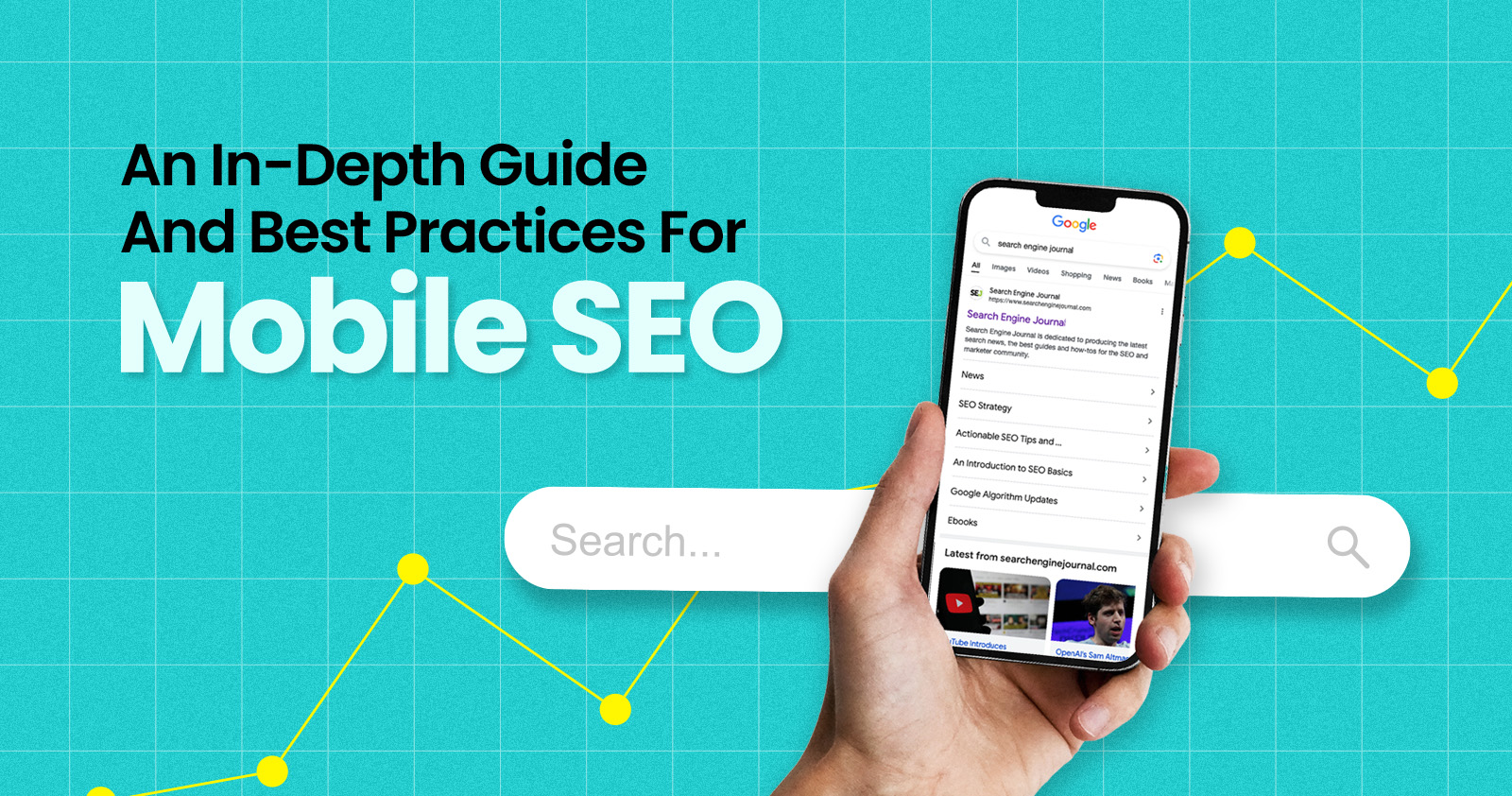
Over the years, search engines have encouraged businesses to improve mobile experience on their websites. More than 60% of web traffic comes from mobile, and in some cases based on the industry, mobile traffic can reach up to 90%.
Since Google has completed its switch to mobile-first indexing, the question is no longer “if” your website should be optimized for mobile, but how well it is adapted to meet these criteria. A new challenge has emerged for SEO professionals with the introduction of Interaction to Next Paint (INP), which replaced First Input Delay (FID) starting March, 12 2024.
Thus, understanding mobile SEO’s latest advancements, especially with the shift to INP, is crucial. This guide offers practical steps to optimize your site effectively for today’s mobile-focused SEO requirements.
What Is Mobile SEO And Why Is It Important?
The goal of mobile SEO is to optimize your website to attain better visibility in search engine results specifically tailored for mobile devices.
This form of SEO not only aims to boost search engine rankings, but also prioritizes enhancing mobile user experience through both content and technology.
While, in many ways, mobile SEO and traditional SEO share similar practices, additional steps related to site rendering and content are required to meet the needs of mobile users and the speed requirements of mobile devices.
Does this need to be a priority for your website? How urgent is it?
Consider this: 58% of the world’s web traffic comes from mobile devices.
If you aren’t focused on mobile users, there is a good chance you’re missing out on a tremendous amount of traffic.
Mobile-First Indexing
Additionally, as of 2023, Google has switched its crawlers to a mobile-first indexing priority.
This means that the mobile experience of your site is critical to maintaining efficient indexing, which is the step before ranking algorithms come into play.
Read more: Where We Are Today With Google’s Mobile-First Index
How Much Of Your Traffic Is From Mobile?
How much traffic potential you have with mobile users can depend on various factors, including your industry (B2B sites might attract primarily desktop users, for example) and the search intent your content addresses (users might prefer desktop for larger purchases, for example).
Regardless of where your industry and the search intent of your users might be, the future will demand that you optimize your site experience for mobile devices.
How can you assess your current mix of mobile vs. desktop users?
An easy way to see what percentage of your users is on mobile is to go into Google Analytics 4.
- Click Reports in the left column.
- Click on the Insights icon on the right side of the screen.
- Scroll down to Suggested Questions and click on it.
- Click on Technology.
- Click on Top Device model by Users.
- Then click on Top Device category by Users under Related Results.
- The breakdown of Top Device category will match the date range selected at the top of GA4.
You can also set up a report in Looker Studio.
- Add your site to the Data source.
- Add Device category to the Dimension field.
- Add 30-day active users to the Metric field.
- Click on Chart to select the view that works best for you.
 Screenshot from Looker Studio, March 2024
Screenshot from Looker Studio, March 2024You can add more Dimensions to really dig into the data to see which pages attract which type of users, what the mobile-to-desktop mix is by country, which search engines send the most mobile users, and so much more.
Read more: Why Mobile And Desktop Rankings Are Different
How To Check If Your Site Is Mobile-Friendly
Now that you know how to build a report on mobile and desktop usage, you need to figure out if your site is optimized for mobile traffic.
While Google removed the mobile-friendly testing tool from Google Search Console in December 2023, there are still a number of useful tools for evaluating your site for mobile users.
Bing still has a mobile-friendly testing tool that will tell you the following:
- Viewport is configured correctly.
- Page content fits device width.
- Text on the page is readable.
- Links and tap targets are sufficiently large and touch-friendly.
- Any other issues detected.
Google’s Lighthouse Chrome extension provides you with an evaluation of your site’s performance across several factors, including load times, accessibility, and SEO.
To use, install the Lighthouse Chrome extension.
- Go to your website in your browser.
- Click on the orange lighthouse icon in your browser’s address bar.
- Click Generate Report.
- A new tab will open and display your scores once the evaluation is complete.
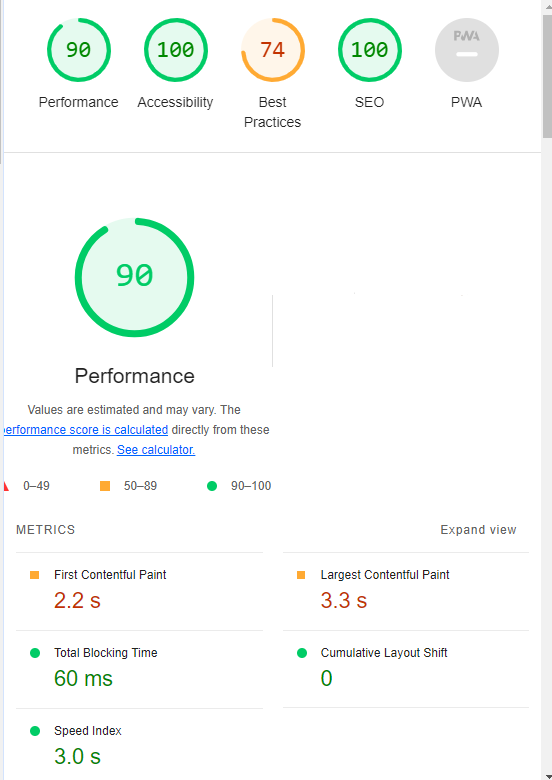 Screenshot from Lighthouse, March 2024
Screenshot from Lighthouse, March 2024You can also use the Lighthouse report in Developer Tools in Chrome.
- Simply click on the three dots next to the address bar.
- Select “More Tools.”
- Select Developer Tools.
- Click on the Lighthouse tab.
- Choose “Mobile” and click the “Analyze page load” button.
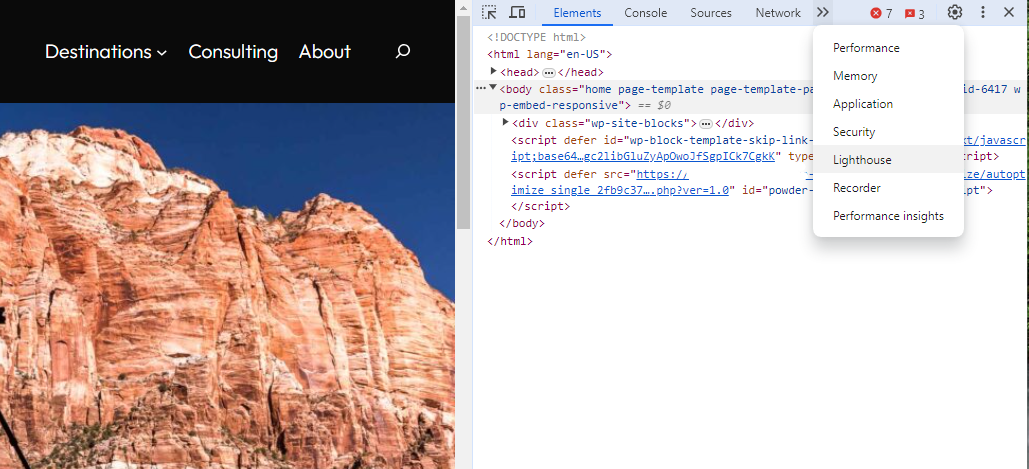 Screenshot from Lighthouse, March 2024
Screenshot from Lighthouse, March 2024Another option that Google offers is the PageSpeed Insights (PSI) tool. Simply add your URL into the field and click Analyze.
PSI will integrate any Core Web Vitals scores into the resulting view so you can see what your users are experiencing when they come to your site.
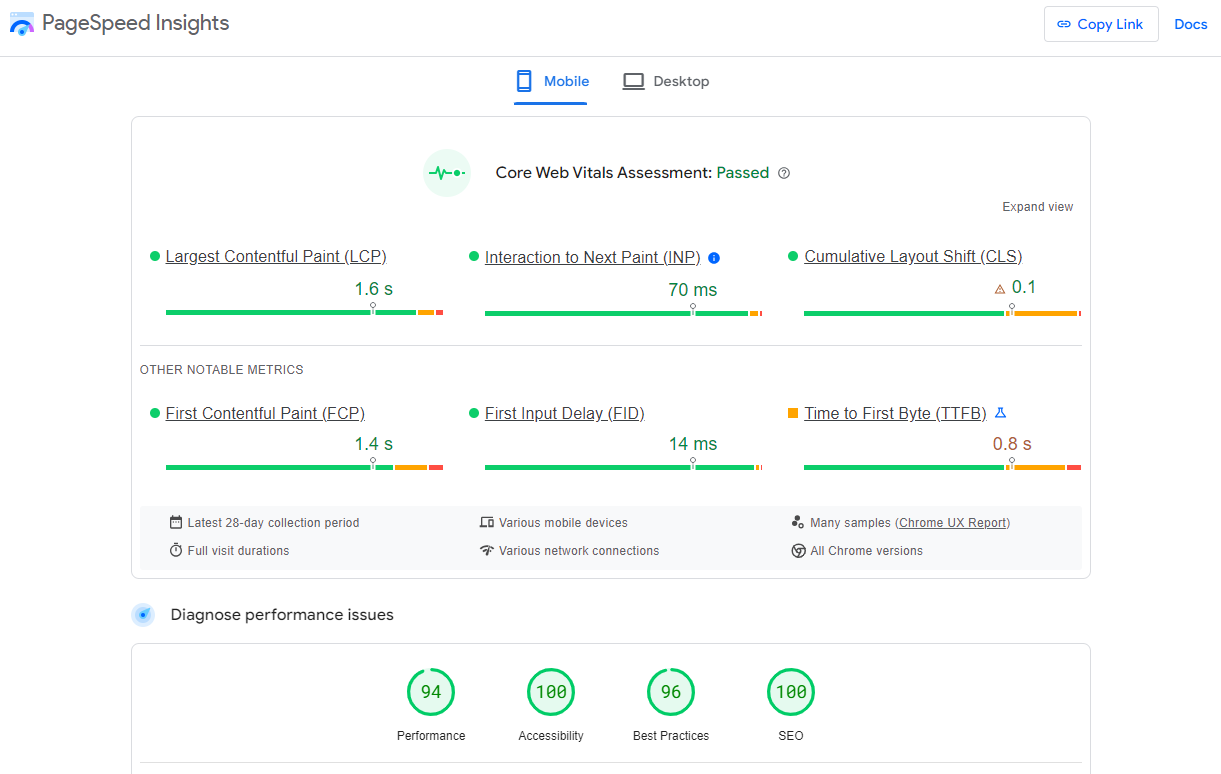 Screenshot from PageSpeed Insights, March 2024
Screenshot from PageSpeed Insights, March 2024Other tools, like WebPageTest.org, will graphically display the processes and load times for everything it takes to display your webpages.
With this information, you can see which processes block the loading of your pages, which ones take the longest to load, and how this affects your overall page load times.
You can also emulate the mobile experience by using Developer Tools in Chrome, which allows you to switch back and forth between a desktop and mobile experience.
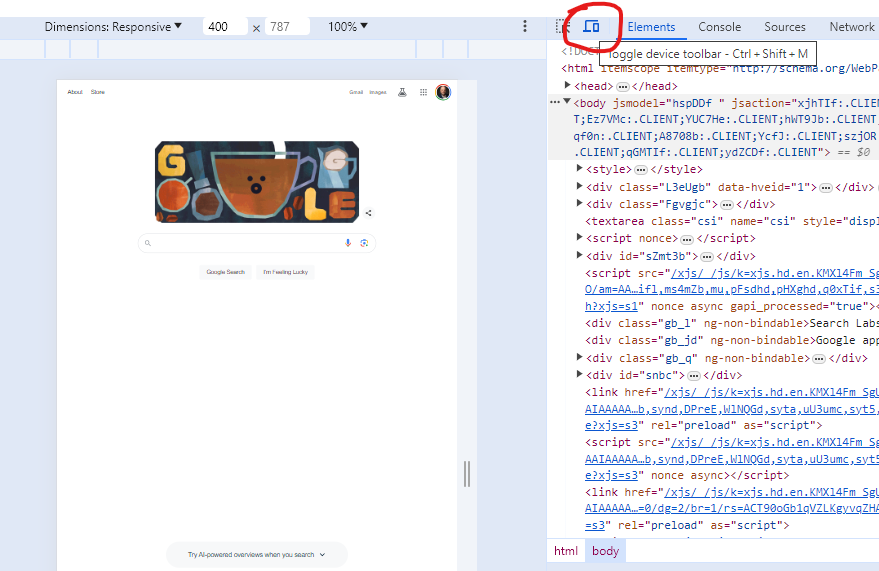 Screenshot from Google Chrome Developer Tools, March 2024
Screenshot from Google Chrome Developer Tools, March 2024Lastly, use your own mobile device to load and navigate your website:
- Does it take forever to load?
- Are you able to navigate your site to find the most important information?
- Is it easy to add something to cart?
- Can you read the text?
Read more: Google PageSpeed Insights Reports: A Technical Guide
How To Optimize Your Site Mobile-First
With all these tools, keep an eye on the Performance and Accessibility scores, as these directly affect mobile users.
Expand each section within the PageSpeed Insights report to see what elements are affecting your score.
These sections can give your developers their marching orders for optimizing the mobile experience.
While mobile speeds for cellular networks have steadily improved around the world (the average speed in the U.S. has jumped to 27.06 Mbps from 11.14 Mbps in just eight years), speed and usability for mobile users are at a premium.
Read more: Top 7 SEO Benefits Of Responsive Web Design
Best Practices For Mobile Optimization
Unlike traditional SEO, which can focus heavily on ensuring that you are using the language of your users as it relates to the intersection of your products/services and their needs, optimizing for mobile SEO can seem very technical SEO-heavy.
While you still need to be focused on matching your content with the needs of the user, mobile search optimization will require the aid of your developers and designers to be fully effective.
Below are several key factors in mobile SEO to keep in mind as you’re optimizing your site.
Site Rendering
How your site responds to different devices is one of the most important elements in mobile SEO.
The two most common approaches to this are responsive design and dynamic serving.
Responsive design is the most common of the two options.
Using your site’s cascading style sheets (CSS) and flexible layouts, as well as responsive content delivery networks (CDN) and modern image file types, responsive design allows your site to adjust to a variety of screen sizes, orientations, and resolutions.
With the responsive design, elements on the page adjust in size and location based on the size of the screen.
You can simply resize the window of your desktop browser and see how this works.
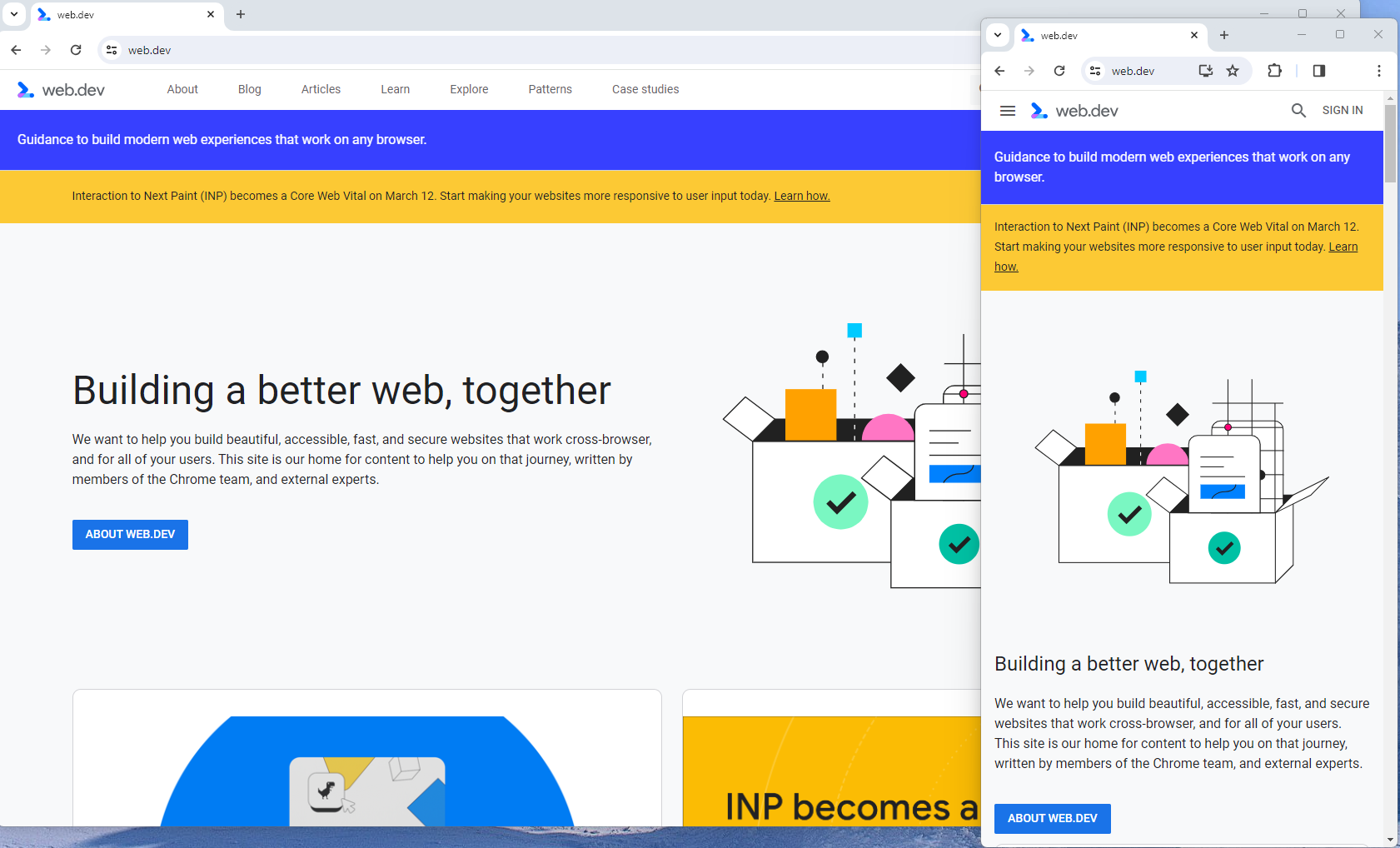 Screenshot from web.dev, March 2024
Screenshot from web.dev, March 2024This is the approach that Google recommends.
Adaptive design, also known as dynamic serving, consists of multiple fixed layouts that are dynamically served to the user based on their device.
Sites can have a separate layout for desktop, smartphone, and tablet users. Each design can be modified to remove functionality that may not make sense for certain device types.
This is a less efficient approach, but it does give sites more control over what each device sees.
While these will not be covered here, two other options:
- Progressive Web Apps (PWA), which can seamlessly integrate into a mobile app.
- Separate mobile site/URL (which is no longer recommended).
Read more: An Introduction To Rendering For SEO
Interaction to Next Paint (INP)
Google has introduced Interaction to Next Paint (INP) as a more comprehensive measure of user experience, succeeding First Input Delay. While FID measures the time from when a user first interacts with your page (e.g., clicking a link, tapping a button) to the time when the browser is actually able to begin processing event handlers in response to that interaction. INP, on the other hand, broadens the scope by measuring the responsiveness of a website throughout the entire lifespan of a page, not just first interaction.
Note that actions such as hovering and scrolling do not influence INP, however, keyboard-driven scrolling or navigational actions are considered keystrokes that may activate events measured by INP but not scrolling which is happeing due to interaction.
Scrolling may indirectly affect INP, for example in scenarios where users scroll through content, and additional content is lazy-loaded from the API. While the act of scrolling itself isn’t included in the INP calculation, the processing, necessary for loading additional content, can create contention on the main thread, thereby increasing interaction latency and adversely affecting the INP score.
What qualifies as an optimal INP score?
- An INP under 200ms indicates good responsiveness.
- Between 200ms and 500ms needs improvement.
- Over 500ms means page has poor responsiveness.
and these are common issues causing poor INP scores:
- Long JavaScript Tasks: Heavy JavaScript execution can block the main thread, delaying the browser’s ability to respond to user interactions. Thus break long JS tasks into smaller chunks by using scheduler API.
- Large DOM (HTML) Size: A large DOM ( starting from 1500 elements) can severely impact a website’s interactive performance. Every additional DOM element increases the work required to render pages and respond to user interactions.
- Inefficient Event Callbacks: Event handlers that execute lengthy or complex operations can significantly affect INP scores. Poorly optimized callbacks attached to user interactions, like clicks, keypress or taps, can block the main thread, delaying the browser’s ability to render visual feedback promptly. For example when handlers perform heavy computations or initiate synchronous network requests such on clicks.
and you can troubleshoot INP issues using free and paid tools.
As a good starting point I would recommend to check your INP scores by geos via treo.sh which will give you a great high level insights where you struggle with most.
 INP scores by Geos
INP scores by GeosRead more: How To Improve Interaction To Next Paint (INP)
Image Optimization
Images add a lot of value to the content on your site and can greatly affect the user experience.
From page speeds to image quality, you could adversely affect the user experience if you haven’t optimized your images.
This is especially true for the mobile experience. Images need to adjust to smaller screens, varying resolutions, and screen orientation.
- Use responsive images
- Implement lazy loading
- Compress your images (use WebP)
- Add your images into sitemap
Optimizing images is an entire science, and I advise you to read our comprehensive guide on image SEO how to implement the mentioned recommendations.
Avoid Intrusive Interstitials
Google rarely uses concrete language to state that something is a ranking factor or will result in a penalty, so you know it means business about intrusive interstitials in the mobile experience.
Intrusive interstitials are basically pop-ups on a page that prevent the user from seeing content on the page.
John Mueller, Google’s Senior Search Analyst, stated that they are specifically interested in the first interaction a user has after clicking on a search result.

Not all pop-ups are considered bad. Interstitial types that are considered “intrusive” by Google include:
- Pop-ups that cover most or all of the page content.
- Non-responsive interstitials or pop-ups that are impossible for mobile users to close.
- Pop-ups that are not triggered by a user action, such as a scroll or a click.
Read more: 7 Tips To Keep Pop-Ups From Harming Your SEO
Structured Data
Most of the tips provided in this guide so far are focused on usability and speed and have an additive effect, but there are changes that can directly influence how your site appears in mobile search results.
Search engine results pages (SERPs) haven’t been the “10 blue links” in a very long time.
They now reflect the diversity of search intent, showing a variety of different sections to meet the needs of users. Local Pack, shopping listing ads, video content, and more dominate the mobile search experience.
As a result, it’s more important than ever to provide structured data markup to the search engines, so they can display rich results for users.
In this example, you can see that both Zojirushi and Amazon have included structured data for their rice cookers, and Google is displaying rich results for both.
 Screenshot from search for [Japanese rice cookers], Google, March 2024
Screenshot from search for [Japanese rice cookers], Google, March 2024Adding structured data markup to your site can influence how well your site shows up for local searches and product-related searches.
Using JSON-LD, you can mark up the business, product, and services data on your pages in Schema markup.
If you use WordPress as the content management system for your site, there are several plugins available that will automatically mark up your content with structured data.
Read more: What Structured Data To Use And Where To Use It?
Content Style
When you think about your mobile users and the screens on their devices, this can greatly influence how you write your content.
Rather than long, detailed paragraphs, mobile users prefer concise writing styles for mobile reading.
Each key point in your content should be a single line of text that easily fits on a mobile screen.
Your font sizes should adjust to the screen’s resolution to avoid eye strain for your users.
If possible, allow for a dark or dim mode for your site to further reduce eye strain.
Headers should be concise and address the searcher’s intent. Rather than lengthy section headers, keep it simple.
Finally, make sure that your text renders in a font size that’s readable.
Read more: 10 Tips For Creating Mobile-Friendly Content
Tap Targets
As important as text size, the tap targets on your pages should be sized and laid out appropriately.
Tap targets include navigation elements, links, form fields, and buttons like “Add to Cart” buttons.
Targets smaller than 48 pixels by 48 pixels and targets that overlap or are overlapped by other page elements will be called out in the Lighthouse report.
Tap targets are essential to the mobile user experience, especially for ecommerce websites, so optimizing them is vital to the health of your online business.
Read more: Google’s Lighthouse SEO Audit Tool Now Measures Tap Target Spacing
Prioritizing These Tips
If you have delayed making your site mobile-friendly until now, this guide may feel overwhelming. As a result, you may not know what to prioritize first.
As with so many other optimizations in SEO, it’s important to understand which changes will have the greatest impact, and this is just as true for mobile SEO.
Think of SEO as a framework in which your site’s technical aspects are the foundation of your content. Without a solid foundation, even the best content may struggle to rank.
- Responsive or Dynamic Rendering: If your site requires the user to zoom and scroll right or left to read the content on your pages, no number of other optimizations can help you. This should be first on your list.
- Content Style: Rethink how your users will consume your content online. Avoid very long paragraphs. “Brevity is the soul of wit,” to quote Shakespeare.
- Image Optimization: Begin migrating your images to next-gen image formats and optimize your content display network for speed and responsiveness.
- Tap Targets: A site that prevents users from navigating or converting into sales won’t be in business long. Make navigation, links, and buttons usable for them.
- Structured Data: While this element ranks last in priority on this list, rich results can improve your chances of receiving traffic from a search engine, so add this to your to-do list once you’ve completed the other optimizations.
Summary
From How Search Works, “Google’s mission is to organize the world’s information and make it universally accessible and useful.”
If Google’s primary mission is focused on making all the world’s information accessible and useful, then you know they will prefer surfacing sites that align with that vision.
Since a growing percentage of users are on mobile devices, you may want to infer the word “everywhere” added to the end of the mission statement.
Are you missing out on traffic from mobile devices because of a poor mobile experience?
If you hope to remain relevant, make mobile SEO a priority now.
Featured Image: Paulo Bobita/Search Engine Journal
SEO
HARO Has Been Dead for a While

I know nothing about the new tool. I haven’t tried it. But after trying to use HARO recently, I can’t say I’m surprised or saddened by its death. It’s been a walking corpse for a while.
I used HARO way back in the day to build links. It worked. But a couple of months ago, I experienced the platform from the other side when I decided to try to source some “expert” insights for our posts.
After just a few minutes of work, I got hundreds of pitches:
So, I grabbed a cup of coffee and began to work through them. It didn’t take long before I lost the will to live. Every other pitch seemed like nothing more than lazy AI-generated nonsense from someone who definitely wasn’t an expert.
Here’s one of them:


Seriously. Who writes like that? I’m a self-confessed dullard (any fellow Dull Men’s Club members here?), and even I’m not that dull…
I don’t think I looked through more than 30-40 of the responses. I just couldn’t bring myself to do it. It felt like having a conversation with ChatGPT… and not a very good one!
Despite only reviewing a few dozen of the many pitches I received, one stood out to me:


Believe it or not, this response came from a past client of mine who runs an SEO agency in the UK. Given how knowledgeable and experienced he is (he actually taught me a lot about SEO back in the day when I used to hassle him with questions on Skype), this pitch rang alarm bells for two reasons:
- I truly doubt he spends his time replying to HARO queries
- I know for a fact he’s no fan of Neil Patel (sorry, Neil, but I’m sure you’re aware of your reputation at this point!)
So… I decided to confront him 😉
Here’s what he said:
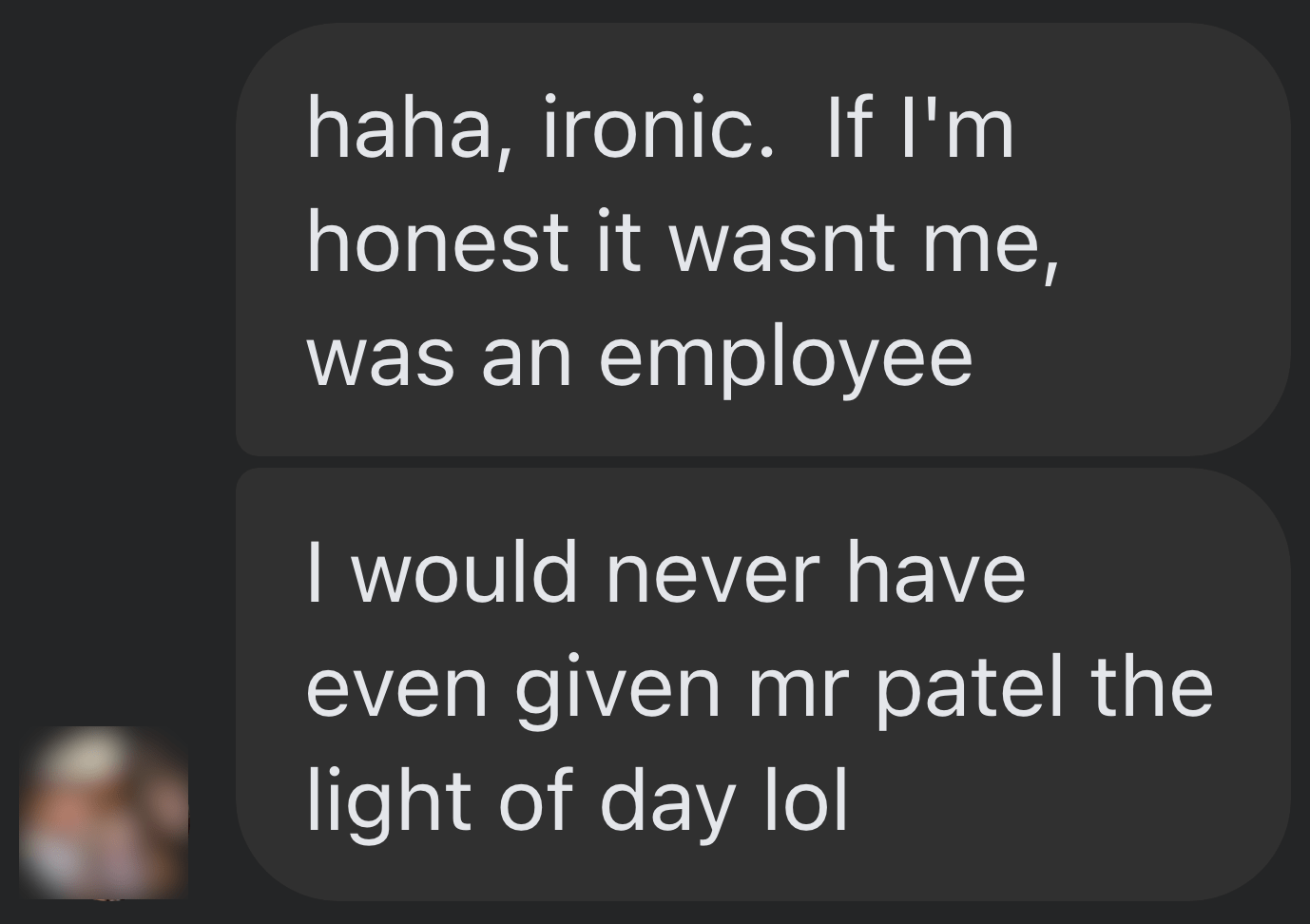

Shocker.
I pressed him for more details:
I’m getting a really good deal and paying per link rather than the typical £xxxx per month for X number of pitches. […] The responses as you’ve seen are not ideal but that’s a risk I’m prepared to take as realistically I dont have the time to do it myself. He’s not native english, but I have had to have a word with him a few times about clearly using AI. On the low cost ones I don’t care but on authority sites it needs to be more refined.
I think this pretty much sums up the state of HARO before its death. Most “pitches” were just AI answers from SEOs trying to build links for their clients.
Don’t get me wrong. I’m not throwing shade here. I know that good links are hard to come by, so you have to do what works. And the reality is that HARO did work. Just look at the example below. You can tell from the anchor and surrounding text in Ahrefs that these links were almost certainly built with HARO:
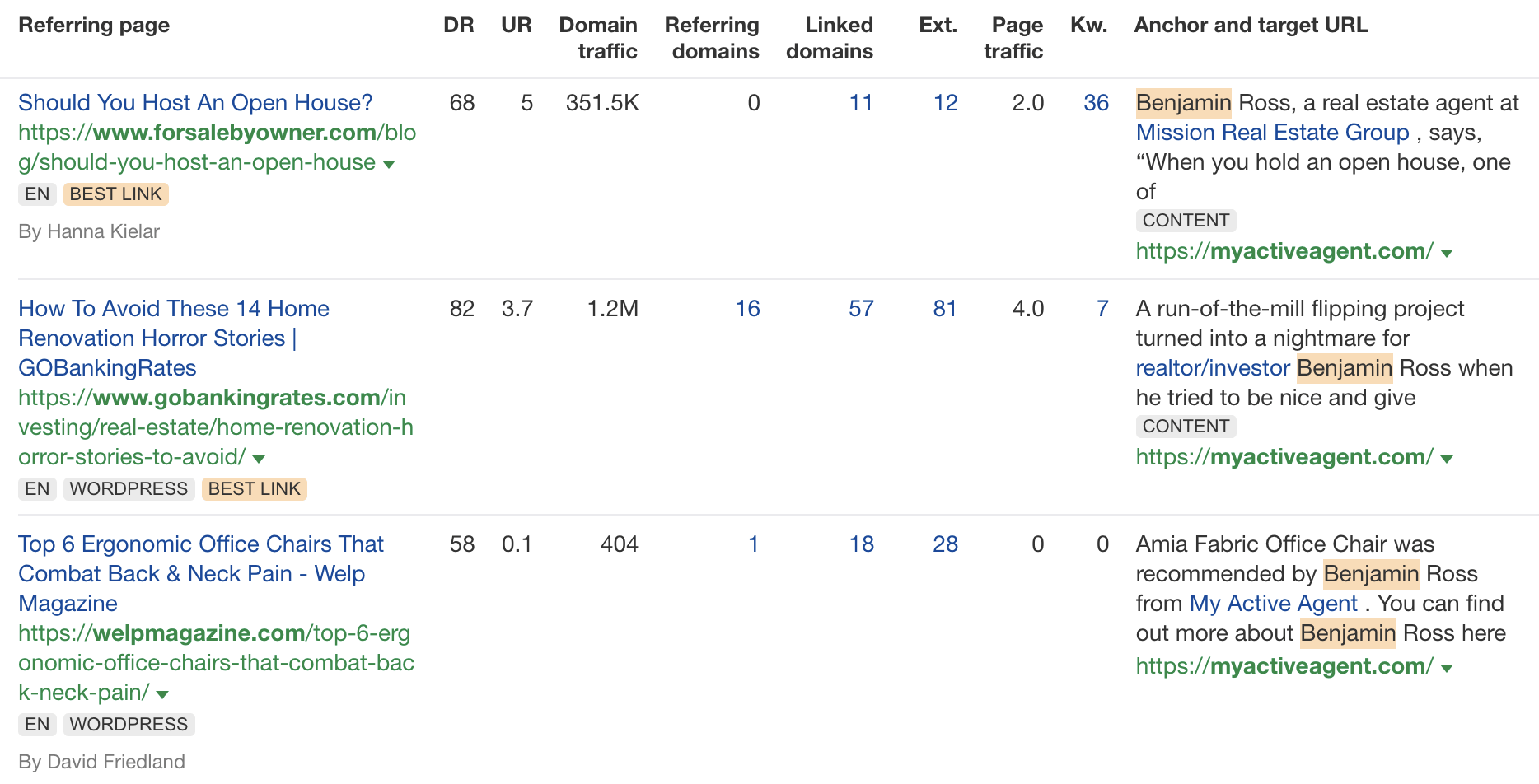

But this was the problem. HARO worked so well back in the day that it was only a matter of time before spammers and the #scale crew ruined it for everyone. That’s what happened, and now HARO is no more. So…
If you’re a link builder, I think it’s time to admit that HARO link building is dead and move on.
No tactic works well forever. It’s the law of sh**ty clickthroughs. This is why you don’t see SEOs having huge success with tactics like broken link building anymore. They’ve moved on to more innovative tactics or, dare I say it, are just buying links.
Sidenote.
Talking of buying links, here’s something to ponder: if Connectively charges for pitches, are links built through those pitches technically paid? If so, do they violate Google’s spam policies? It’s a murky old world this SEO lark, eh?
If you’re a journalist, Connectively might be worth a shot. But with experts being charged for pitches, you probably won’t get as many responses. That might be a good thing. You might get less spam. Or you might just get spammed by SEOs with deep pockets. The jury’s out for now.
My advice? Look for alternative methods like finding and reaching out to experts directly. You can easily use tools like Content Explorer to find folks who’ve written lots of content about the topic and are likely to be experts.
For example, if you look for content with “backlinks” in the title and go to the Authors tab, you might see a familiar name. 😉


I don’t know if I’d call myself an expert, but I’d be happy to give you a quote if you reached out on social media or emailed me (here’s how to find my email address).
Alternatively, you can bait your audience into giving you their insights on social media. I did this recently with a poll on X and included many of the responses in my guide to toxic backlinks.


Either of these options is quicker than using HARO because you don’t have to sift through hundreds of responses looking for a needle in a haystack. If you disagree with me and still love HARO, feel free to tell me why on X 😉
SEO
Google Clarifies Vacation Rental Structured Data

Google’s structured data documentation for vacation rentals was recently updated to require more specific data in a change that is more of a clarification than it is a change in requirements. This change was made without any formal announcement or notation in the developer pages changelog.
Vacation Rentals Structured Data
These specific structured data types makes vacation rental information eligible for rich results that are specific to these kinds of rentals. However it’s not available to all websites. Vacation rental owners are required to be connected to a Google Technical Account Manager and have access to the Google Hotel Center platform.
VacationRental Structured Data Type Definitions
The primary changes were made to the structured data property type definitions where Google defines what the required and recommended property types are.
The changes to the documentation is in the section governing the Recommended properties and represents a clarification of the recommendations rather than a change in what Google requires.
The primary changes were made to the structured data type definitions where Google defines what the required and recommended property types are.
The changes to the documentation is in the section governing the Recommended properties and represents a clarification of the recommendations rather than a change in what Google requires.
Address Schema.org property
This is a subtle change but it’s important because it now represents a recommendation that requires more precise data.
This is what was recommended before:
“streetAddress”: “1600 Amphitheatre Pkwy.”
This is what it now recommends:
“streetAddress”: “1600 Amphitheatre Pkwy, Unit 6E”
Address Property Change Description
The most substantial change is to the description of what the “address” property is, becoming more descriptive and precise about what is recommended.
The description before the change:
PostalAddress
Information about the street address of the listing. Include all properties that apply to your country.
The description after the change:
PostalAddress
The full, physical location of the vacation rental.
Provide the street address, city, state or region, and postal code for the vacation rental. If applicable, provide the unit or apartment number.
Note that P.O. boxes or other mailing-only addresses are not considered full, physical addresses.
This is repeated in the section for address.streetAddress property
This is what it recommended before:
address.streetAddress Text
The full street address of your vacation listing.
And this is what it recommends now:
address.streetAddress Text
The full street address of your vacation listing, including the unit or apartment number if applicable.
Clarification And Not A Change
Although these updates don’t represent a change in Google’s guidance they are nonetheless important because they offer clearer guidance with less ambiguity as to what is recommended.
Read the updated structured data guidance:
Vacation rental (VacationRental) structured data
Featured Image by Shutterstock/New Africa
-

 WORDPRESS6 days ago
WORDPRESS6 days agoTurkish startup ikas attracts $20M for its e-commerce platform designed for small businesses
-

 PPC7 days ago
PPC7 days agoA History of Google AdWords and Google Ads: Revolutionizing Digital Advertising & Marketing Since 2000
-

 MARKETING6 days ago
MARKETING6 days agoRoundel Media Studio: What to Expect From Target’s New Self-Service Platform
-
SEARCHENGINES5 days ago
Daily Search Forum Recap: April 12, 2024
-

 SEO5 days ago
SEO5 days agoGoogle Limits News Links In California Over Proposed ‘Link Tax’ Law
-

 MARKETING7 days ago
MARKETING7 days agoUnlocking the Power of AI Transcription for Enhanced Content Marketing Strategies
-

 SEO4 days ago
SEO4 days ago10 Paid Search & PPC Planning Best Practices
-

 SEARCHENGINES6 days ago
SEARCHENGINES6 days agoGoogle Search Results Can Be Harmful & Dangerous In Some Cases















You must be logged in to post a comment Login